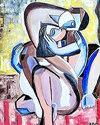POSTGENOMIC WITNESSES
IF 0.3
4区 社会学
0 HUMANITIES, MULTIDISCIPLINARY
ANGELAKI-JOURNAL OF THE THEORETICAL HUMANITIES
Pub Date : 2022-03-04
DOI:10.1080/0969725X.2022.2046359
引用次数: 0
Abstract
Abstract In 2013, Gail Davies and Helen Scalway launched Micespace.org, an interactive web-based art and research project that uses the platform of a mock mouse model repository to visualize the complex spatial and digital networks of the postgenomic sciences. The website creates an immersive experience of the process of researching and purchasing a mouse model from a genetics repository – one can tour laboratory plans, browse stock and purchase mice, or review genetic security protocol. Functioning as a mock-mutant mouse repository, Micespace.org disrupts narratives of transgenic mice as uncontested scientific objects that bear and bear witness to human disease. Micespace.org uses speculative visualization to allow us to witness the institutional spaces of the postgenomics laboratory where the bodies of mice are transformed from biological beings into scientific data, from animals to scientific objects. In this paper, I suggest that Micespace.org satirizes contemporary forms of bioscientific witnessing and testimony that are built into the apparati of postgenomic consortiums – where massive amounts of data are collected to construct and disseminate animal bodies that can more completely model the human biological system. However, mice have their own genetic make-up that is just as complicated as humans. This means that the genetic similarity that scientists cultivate within transgenic mice through gene splicing, knocking, and immune manipulation, is never complete and what we are left with are genetically fragmented creatures that bear witness to the contradictory relationship between humans, animals, and the genetic science. This paper has two central arguments. First, the website exposes the epistemological processes involved in making mice into models of human bodies that support narratives of bodily similarity between humans and mice to sell them as model organisms. Second, to better understand how the mutant mouse repository functions, I conceptualize it as an archive of forced bodily similarity, to grasp the immensity of the project to make mice as close as possible to us. The enduring questions that guide this paper are how do we bear witness to mutant mice in repositories and how can we comprehend mice themselves as witnesses to this endeavor?后基因组见证人
摘要2013年,Gail Davies和Helen Scalway启动了Micespace.org,这是一个基于网络的互动艺术和研究项目,使用模拟小鼠模型库平台来可视化后基因组科学的复杂空间和数字网络。该网站为从基因库研究和购买小鼠模型的过程创造了身临其境的体验——人们可以参观实验室计划,浏览库存和购买小鼠,或者查看基因安全协议。Micespace.org作为一个模拟突变小鼠库,颠覆了转基因小鼠作为承载和见证人类疾病的无争议科学对象的说法。Micespace.org使用推测性可视化,让我们能够见证后基因组学实验室的制度空间,在那里,小鼠的身体从生物转化为科学数据,从动物转化为科学对象。在这篇论文中,我建议Micespace.org讽刺当代形式的生物科学见证和证词,这些见证和证词是建立在后基因组联盟的表象中的——在后基因组联合体中,收集大量数据来构建和传播可以更完整地模拟人类生物系统的动物身体。然而,老鼠有自己的基因构成,和人类一样复杂。这意味着,科学家通过基因剪接、敲除和免疫操纵在转基因小鼠体内培养的基因相似性永远不完整,我们所剩下的是基因碎片化的生物,见证了人类、动物和遗传科学之间的矛盾关系。这篇论文有两个核心论点。首先,该网站揭示了将老鼠制作成人体模型所涉及的认识论过程,这些过程支持关于人和老鼠身体相似性的叙述,并将其作为模型生物出售。其次,为了更好地理解突变小鼠储存库是如何运作的,我将其概念化为一个强迫身体相似性的档案,以了解让小鼠尽可能靠近我们的项目的巨大性。指导这篇论文的持久问题是,我们如何见证储存库中的突变小鼠,以及我们如何理解小鼠本身作为这一努力的见证人?
本文章由计算机程序翻译,如有差异,请以英文原文为准。
求助全文
约1分钟内获得全文
求助全文
来源期刊

ANGELAKI-JOURNAL OF THE THEORETICAL HUMANITIES
HUMANITIES, MULTIDISCIPLINARY-
CiteScore
0.60
自引率
33.30%
发文量
57
期刊介绍:
Angelaki: journal of the theoretical humanities was established in September 1993 to provide an international forum for vanguard work in the theoretical humanities. In itself a contentious category, "theoretical humanities" represents the productive nexus of work in the disciplinary fields of literary criticism and theory, philosophy, and cultural studies. The journal is dedicated to the refreshing of intellectual coordinates, and to the challenging and vivifying process of re-thinking. Angelaki: journal of the theoretical humanities encourages a critical engagement with theory in terms of disciplinary development and intellectual and political usefulness, the inquiry into and articulation of culture.
 求助内容:
求助内容: 应助结果提醒方式:
应助结果提醒方式:


